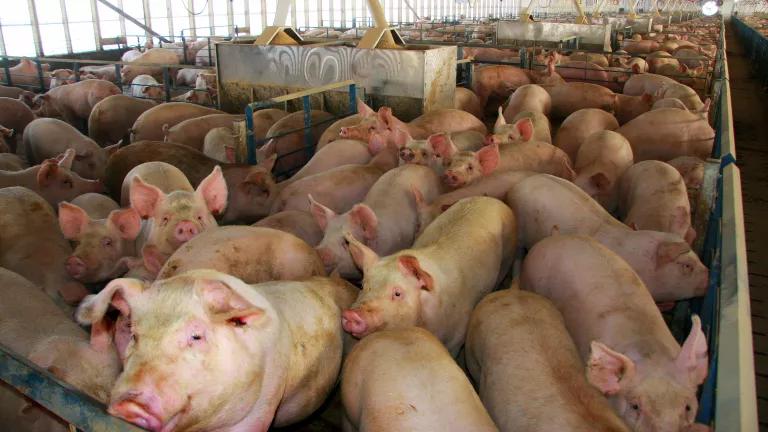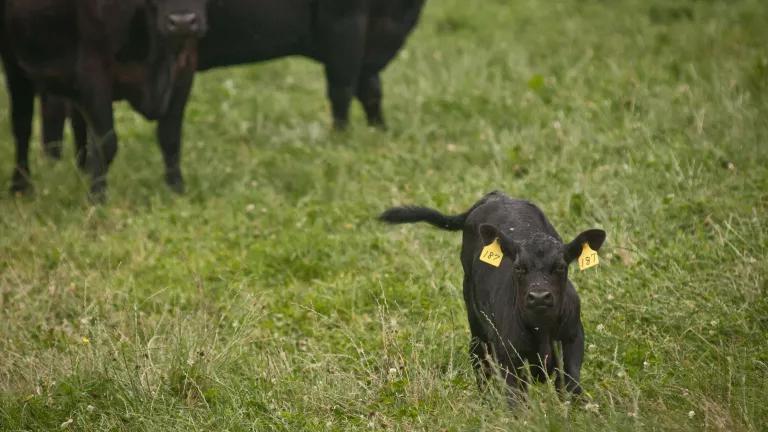Wendy's Moves Forward on Antibiotics, Others Stand Still
We can still stop the slow-moving runaway train that is the antibiotic resistance crisis.

Beef cattle at a feedlot in Floresville, Texas
We can still stop the slow-moving runaway train that is the antibiotic resistance crisis.
Global health experts have long considered antibiotic resistance one of the top health threats in the world; that alarm bell is ringing even louder now as we live through the COVID-19 pandemic and the havoc it has wreaked on our health, lives, and economies.
The antibiotic resistance health crisis is unfolding and growing alongside the COVID-19 pandemic. If urgent action isn’t taken now to stop the overuse of antibiotics, the annual global death toll from antibiotic resistant infections is expected to exceed 10 million people by 2050. Given that nearly two-thirds of medically important antibiotics in the United States are sold for use on food animals rather than human medicine, NRDC and our allies have been laser-focused on reforms in this sector.
Since 2015, NRDC and our allies in the Antibiotics Off the Menu coalition have published the Chain Reaction report, which rates the antibiotic use policies and practices of the top U.S. restaurant chains. Dozens of commitments from these companies in the last six years—including from prominent players like McDonald’s, Subway, Starbucks, and more—helped transform how these drugs are used in the U.S. chicken sector. But for too long, the progress stopped here. Few companies were committing to reducing antibiotic use in their beef and pork supplies. Meanwhile, according to FDA data, sales of medically important drugs for use on cows and pigs are rising.

Chain Reaction VI Antibiotics Scorecard (2021)
Too Many Restaurant Chains Continue to Fail
The 2021 Chain Reaction scorecard shows a few hints of progress and a whole lot of status quo.
Wendy’s is the big news, moving from a “D+” grade in 2019 to a solid “C” for its new commitment to end all routine use of medically important drugs in their beef supplies by the end of 2030. Though the long-lead timeframe doesn’t match the urgency of this health threat, Wendy’s is sending a clear signal to the U.S. beef industry that it needs to reverse course. (As of 2019, medically important sales for use on cows are nearly tied with those for use on pigs. It is more than 13 times higher than sales for use on chicken). Wendy’s continued progress on antibiotics is particularly impressive given the challenges posed to the restaurant industry by the COVID-19 pandemic last year.

Antibiotics Off the Menu coalition members near a Dublin, Ohio, Wendy's restaurant (2019)
In contrast, industry giants McDonald’s and Subway are at a standstill. Both adopted policies pledging to reform antibiotic use in their beef supplies in recent years. Those pledges are looking a lot like empty promises given the lack of follow-through on implementation.
The lack of action on the part of McDonald’s is particularly disappointing. After coming out with a strong policy in 2018, the company failed to meet its own deadline to establish use reduction targets by the end of 2020. In fact, well into 2021, no further details are available as to its plans. Given that McDonald’s is one of the largest beef buyers on the planet, their actions can set a course of change—or risk holding everyone else back.
Urgent Need for Federal Leadership
As restaurant chains slowly reshape antibiotic use policies in the marketplace, the Biden administration remains quiet on this issue. This sets the United States (and the world) further behind in proactively managing this public health crisis. To start making significant and immediate change, the administration should consider a two-pronged approach to addressing the overuse and misuse of antibiotics in livestock:
- First, we urge the administration to establish a national reduction target for livestock use as soon as possible. This will provide a key benchmark against which to measure change.
- Second, the administration should encourage the development a robust tracking system for antibiotic use and resistance in bacteria on and off farms. Right now, the public and decision makers are in the dark about how antibiotics are used on farms. Increasing transparency will help inform appropriate interventions.
Together, these actions will provide critical incentives and information to spur change.
More Food for Thought
Ultimately, antibiotic overuse in the livestock sector is just one of many problems plaguing the animal agriculture sector in the United States. The overuse and misuse of antibiotics is fueled by unhealthy, heavily concentrated meat production system that exploits workers, houses animals in crowded, stressful and unsanitary conditions, exacerbates climate change, and harms communities.
In the long run, our food system needs to be reshaped towards one that is regenerative and protective of people, animals and our planet. We need highly impactful brands, like those surveyed in our report, to make bold and progressive movements in their antibiotics and broader food-sourcing policies to help jump-start change.




